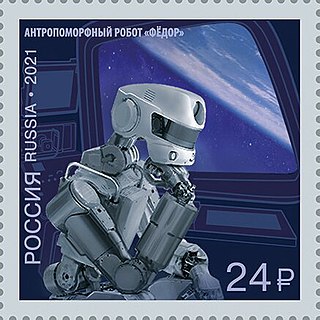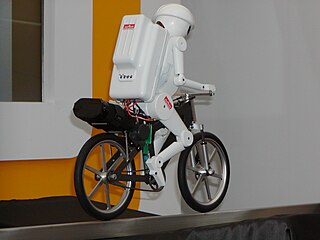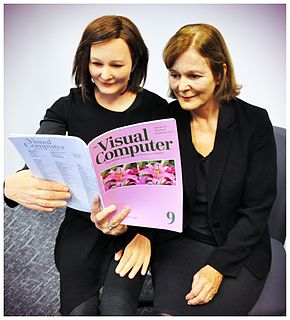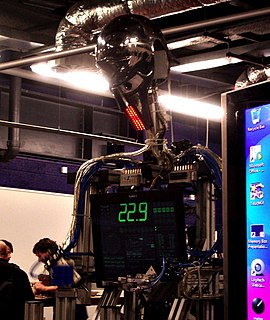 W
WA humanoid robot is a robot resembling the human body in shape. The design may be for functional purposes, such as interacting with human tools and environments, for experimental purposes, such as the study of bipedal locomotion, or for other purposes. In general, humanoid robots have a torso, a head, two arms, and two legs, though some humanoid robots may replicate only part of the body, for example, from the waist up. Some humanoid robots also have heads designed to replicate human facial features such as eyes and mouths. Androids are humanoid robots built to aesthetically resemble humans.
 W
WA gynoid, or fembot, is a feminine humanoid robot. Gynoids appear widely in science fiction film and art. As more realistic humanoid robot design becomes technologically possible, they are also emerging in real-life robot design.
 W
WCog was a project at the Humanoid Robotics Group of the Massachusetts Institute of Technology. It was based on the hypothesis that human-level intelligence requires gaining experience from interacting with humans, like human infants do. This in turn required many interactions with humans over a long period. Because Cog's behavior responded to what humans would consider appropriate and socially salient environmental stimuli, the robot was expected to act more human. This behavior also provided the robot with a better context for deciphering and imitating human behavior. This was intended to allow the robot to learn socially, as humans do.
 W
WElektro is the nickname of a robot built by the Westinghouse Electric Corporation in its Mansfield, Ohio facility between 1937 and 1938. Seven feet tall, weighing 265 pounds (120.2 kg), humanoid in appearance, he could walk by voice command, speak about 700 words, smoke cigarettes, blow up balloons, and move his head and arms. Elektro's body consisted of a steel gear, cam and motor skeleton covered by an aluminum skin. His photoelectric "eyes" could distinguish red and green light. He was on exhibit at the 1939 New York World's Fair and reappeared at that fair in 1940, with "Sparko", a robot dog that could bark, sit, and beg to humans.
 W
WEnon is a personal assistant robot first offered for sale in September 2005. Enon was developed by two companies: Fujitsu Frontech Limited and Fujitsu Laboratories Ltd. The six-million yen (US$60,000) rolling robot is self-guiding, with limited speech recognition and synthesis. Enon can amongst others be used to provide guidance, transport objects, escort guests and perform security patrolling, according to the organization. Enon, an English acronym for "Exciting Nova On Network," can pick up and carry roughly 500 grams (1 lb) in its arms and comes without software.
 W
WEric was the first British robot, built in 1928 by First World War veteran Captain William Richards, and aircraft engineer Alan Reffell. He was constructed to open the Exhibition of the Society of Model Engineers at London's Royal Horticultural Hall in 1928, after George VI cancelled and an exasperated Richards, the exhibition's secretary, offered to "make a man of tin" to take the Duke's place. At the event's opening, Eric rose to his feet, bowed and gave a four-minute opening address.
 W
WFEDOR, colloquially known as Fyodor the robot, is a Russian humanoid robot that replicates movements of a remote operator and can perform some actions autonomously. Originally intended for rescue operations, it was sent on an experimental mission to the International Space Station in 2019. FEDOR is an acronym for "Final Experimental Demonstration Object Research" and a hint to the Russian male given name Fyodor (Фёдор) when transliterated without diacritics.
 W
WGakutensoku, the first robot to be built in the East, was created in Osaka in the late 1920s. The robot was designed and manufactured by biologist Makoto Nishimura. Nishimura had served as a professor at Hokkaido Imperial University, studied Marimo and was an editorial adviser to the Osaka Mainichi newspaper.
 W
WGeorge is a British humanoid robot created by Tony Sale in 1949. The robot was built using scrap metals from a crashed RAF Wellington bomber. George was reactivated in 2010 by Sale and is on display at The National Museum of Computing at Bletchley Park.
 W
WInkha is an interactive robotic head which was created in 2002 at King's College London by Mat Walker and Peter S. Longyear.
 W
WInMoov is a humanoid robot, constructed out of 3D printable plastic body components, and controlled by Arduino microcontrollers.
 W
WIsaacRobot is a biped humanoid robot, produced and realized by the IsaacTeam, a group of students of the Politecnico di Torino.
 W
WKismet is a robot head made in the 1990s at Massachusetts Institute of Technology by Dr. Cynthia Breazeal as an experiment in affective computing; a machine that can recognize and simulate emotions. The name Kismet comes from a Turkish word meaning "fate" or sometimes "luck".
 W
WLeonardo's robot, or Leonardo's mechanical knight, was a humanoid automaton designed and possibly constructed by Leonardo da Vinci around the year 1495.
 W
WManav is India's first humanoid robot which was developed in the laboratory of A-SET Training and Research Institutes by Diwakar Vaish in late December 2014. It debuted at the IIT-Bombay Techfest 2014-15 in Mumbai.
 W
WAnybots Inc. is a robotics company founded in 2001 by Trevor Blackwell in Santa Clara, California. David Rogan became CEO in July 2012.
 W
WMurata Boy and Murata Girl are two self-balancing robots developed by Murata Manufacturing, a Japanese electronic components company. The company developed the robots to showcase a range of their products and generate publicity. The robots are designed to be as energy-efficient as possible, both in their basic technological components and through features like automatic sleep mode.
 W
WNadine is a ginoide humanoid social robot that is modelled on Professor Nadia Magnenat Thalmann. The robot has a strong human-likeness with a natural-looking skin and hair and realistic hands. Nadine is a socially intelligent robot which returns a greeting, makes eye contact, and can remember all the conversations had with it. It is able to answer questions autonomously in several languages, simulate emotions both in gestures and facially, depending on the content of the interaction with the user. Nadine can recognise persons it has previously seen, and engage in flowing conversation. Nadine has been programmed with a "personality", in that its demeanour can change according to what is said to it. Nadine has a total of 27 degrees of freedom for facial expressions and upper body movements. With persons it has previously encountered, it remembers facts and events related to each person. It can assist people with special needs by reading stories, showing images, put on Skype sessions, send emails, and communicate with other members of the family. It can play the role of a receptionist in an office or be dedicated to be a personal coach.
 W
WThe Omnibot (オムニボット) is a toy robot originally manufactured by Tomy in the mid-1980s. The name then came to apply to the successful line of robots manufactured by the company. The initial Omnibot was announced with expectations of restoring popular interest in robots, at a time when it was becoming obvious that robots with advanced AI such as R2-D2 were still a long way away. A more advanced version of the Omnibot was called the Omnibot 2000 and did not have a plastic bubble over its head. With the success of the Omnibots, the Omnibot range quickly expanded. After the video game crash of 1983 and its debilitating effect on the nascent home electronics industry, the Omnibot faded away but it was revived in the early 2000s. The latest version of the Omnibot is the i-SOBOT.
 W
WPepper is a semi-humanoid robot manufactured by SoftBank Robotics, designed with the ability to read emotions. It was introduced in a conference on 5 June 2014, and was showcased in SoftBank Mobile phone stores in Japan beginning the next day. Pepper's ability to recognize emotion is based on detection and analysis of facial expressions and voice tones. Production of Pepper was paused in June 2021, due to weak demand.
 W
WGeoff Peterson is an animatronic human skeleton that served as the sidekick on the late-night talk show The Late Late Show with Craig Ferguson. He was voiced and operated by Josh Robert Thompson and first appeared on The Late Late Show on April 5, 2010. Often referred to as a "robot skeleton", Peterson is a radio-controlled animatronic robot puppet designed and built by Grant Imahara of MythBusters. He has glowing blue eyes, a metal mohawk and wears an oversized suit with his name scrawled on a contestant's name tag from The Price Is Right on his jacket, as well as Mardi Gras beads and a Super Bowl XLVII press pass around his neck. He serves as a co-host of sorts and Ferguson refers to him as "my gay robot pal". He was most visible during the first half of the show and the final segment, "What Did We Learn on the Show Tonight, Craig?".
 W
WWillow Garage was a robotics research lab and technology incubator devoted to developing hardware and open source software for personal robotics applications. The company was most likely best known for its open source software suite ROS, which has been rapidly and widely becoming a common, standard tool among robotics researchers and industry, since its initial release in 2010. It was started in late 2006 by Scott Hassan, who had worked with Larry Page and Sergey Brin to develop the technology that became the Google Search engine. Steve Cousins was the president and CEO. Willow Garage was located in Menlo Park, California.
 W
WAnybots Inc. is a robotics company founded in 2001 by Trevor Blackwell in Santa Clara, California. David Rogan became CEO in July 2012.
 W
WRashmi is an Indian humanoid robot developed by Ranjit Shrivastava, a programmer from Ranchi, India.
 W
WRibo is the first social humanoid robot which can speak in Bengali. Ribo was created by RoboSUST, a robotics group of Shahjalal University of Science & Technology, Bangladesh. The team was supervised by Muhammed Zafar Iqbal. Bangladesh Science Fiction Society funded for making this humanoid robot Ribo. Ribo was first appeared in public on 11 December 2015 in a Science Fiction Festival held at the Public Library, Shahbag.
 W
WRuBot II is a Rubik's Cube solving robot developed by Irish roboticist and inventor Pete Redmond. RuBot II was formerly the world's fastest Rubik's Cube-solving robot, and appeared as such in the 2010 Guinness Book of World Records, although its best time has since been well surpassed by a robot called Ruby built at Swinburne University of Technology in Melbourne, Australia in 2011.
 W
WSalvius is the first open source humanoid robot to be built in the United States. Introduced in 2008, Salvius, whose name is derived from the word 'salvaged', has been constructed with an emphasis on using recycled components and materials to reduce the costs of designing and construction. The robot is designed to be able to perform a wide range of tasks by having a body structure that is similar to that of a human. The primary goal for Salvius is to create a robot that can function dynamically in a domestic environment.
 W
WSanbot is an intelligent, cloud-enabled service robot developed by Qihan Technology Co. Ltd., a robotics and AI company headquartered in Shenzhen, China. Now Qihan has launched three generation intelligent robots under Sanbot brand – Sanbot Elf(QIHAN Technology renamed the first generation Sanbot to Sanbot Elf), Sanbot King Kong and Sanbot Nano.
 W
WSEROPI is a wheel based humanoid robot developed by KITECH.
 W
WRobot Shalu is the world's first homemade artificially intelligent multilingual social and educational humanoid robot, made-up of waste materials, that can speak 47 languages i.e. 9 Indian and 38 foreign languages.
 W
WSophia is a Saudi Arabian social humanoid robot developed by the Hong Kong-based company Hanson Robotics. Sophia was activated on February 14, 2016, and made its first public appearance in mid-March 2016 at South by Southwest (SXSW) in Austin, Texas, United States.
 W
WBranimir Makanec is a Croatian computer engineer and programmer. Outside of his research work, he is also known in his native country as a pioneering advocate for computer literacy amongst school-aged children.
 W
WWakamaru is a Japanese robot made by Mitsubishi Heavy Industries that is intended to perform natural communication with human beings. The yellow, 3-foot domestic robot debuted in 2005 at a $14,300-$15,000 USD price-point exclusively for Japanese households. Through its development, the Wakamaru has been used for presenting at exhibitions, guiding customers, and working as a desk receptionist. However, the Wakamaru has not advanced beyond its first model that was released in 2005.